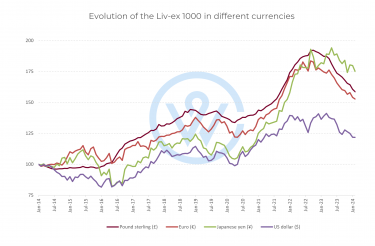- Buying demand for fine wine is impacted by the global economy, where currency volatility plays a significant role.
- Fine wine indices are frequently quoted in sterling (GBP), making the currency’s strength or weakness a pivotal factor affecting both domestic and international transactions.
- A stronger pound makes UK-sourced fine wines more expensive for foreign buyers, potentially dampening demand and leading to falls in the indices.
Although uncorrelated to mainstream markets, the fine wine market does not exist in a vacuum. Buying demand and investment interest are impacted by the global economy, where currency volatility plays a significant role.
For investors, understanding the impact of currency movements, especially in a market where prices and indices are often denominated in sterling, is crucial. Here’s how currency volatility influences the fine wine market and strategies investors can employ to navigate these turbulent waters.
The impact of currency volatility
Currency volatility refers to the fluctuations in the value of one currency relative to another. For the fine wine market, which is global, these fluctuations can have a pronounced impact. Prices and indices for fine wine are frequently quoted in sterling (GBP), making the British currency’s strength or weakness a pivotal factor affecting both domestic and international transactions.
When the pound weakens against major currencies like the dollar or euro, fine wine prices in the UK become more attractive to foreign buyers. This increased demand from abroad can drive up prices, as buyers look to capitalise on favourable exchange rates to purchase high-quality wines at lower relative costs. Conversely, when the pound strengthens, as is the case currently, fine wine prices can seem more expensive to foreign buyers, potentially leading to a decrease in international demand and a stabilisation or even fall in the indices that track them.
Real-world implications
Consider the aftermath of the Brexit referendum in June 2016, when the pound experienced a significant drop against the dollar and euro. This scenario offered a golden opportunity for foreign investors, particularly from the US and Asia, who found that their purchasing power had increased overnight. As a result, demand for fine wines priced in sterling surged, driving up fine wine prices.
The Liv-ex Fine Wine 1000 Index, which is the broadest measure of the market and tracks the price movement of 1000 of the most sought-after fine wines, showed upward price movement of 14% in the six months following the referendum. Its rise in sterling was uninterrupted until August 2017. In just over a year, the index rose 21.7%.
This trend was largely fuelled by foreign investors taking advantage of the weaker pound to expand their collections.
Sterling’s strength and its effects
On the flip side, periods of sterling strength present a different picture. A stronger pound makes UK-sourced fine wines more expensive for foreign buyers, potentially dampening demand. This has contributed to a fall in the Liv-ex 1000 index, denominated in sterling. However, when seen in other currencies, the fall in fine wine prices is less sharp.

The Liv-ex 1000 index peaked in October 2022 in sterling; since then, the index has dipped 17.5%.
But the losses since its peak have been smaller in alternative currencies. The index hit its highest point in euro in June 2022 and has fallen 16.4% since. In US dollar, the index peaked in March 2023; since then, it has fallen 14%. In Japanese Yen, the Liv-ex 1000 peaked in May 2023 and has fallen 10% since.
A global market with local prices
While fine wine prices may be quoted in sterling, the global nature of the market means that prices inherently hold their value in alternative currencies. This resilience is partly because the value of fine wine is not solely dependent on currency movements but also on factors such as vintage quality, brand reputation, and scarcity.
For instance, a classic Bordeaux vintage will maintain its allure and value to collectors worldwide, regardless of short-term currency fluctuations. This universal appeal ensures that while prices in sterling may rise or fall with the pound’s strength, the intrinsic value of fine wines remains recognised across currencies.
Strategies for investors
Investors can leverage currency volatility to their advantage by staying informed about global economic trends and currency forecasts. Purchasing fine wines when the pound is weak can offer significant value, while selling during periods of sterling strength may maximize returns.
Currency volatility is a double-edged sword in the fine wine market, presenting both opportunities and challenges. Whether taking advantage of a weaker pound to acquire coveted wines or diversifying investments to mitigate risks, the key lies in informed decision-making and a keen eye on the ever-changing economic landscape.
Speak to one of our wine investment experts and start building your portfolio. Schedule your free consultation today.
